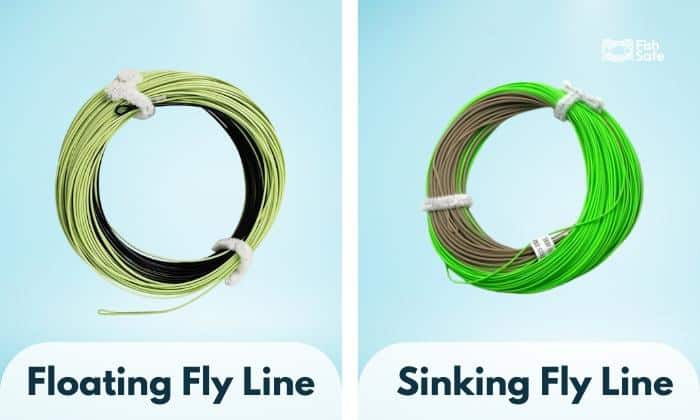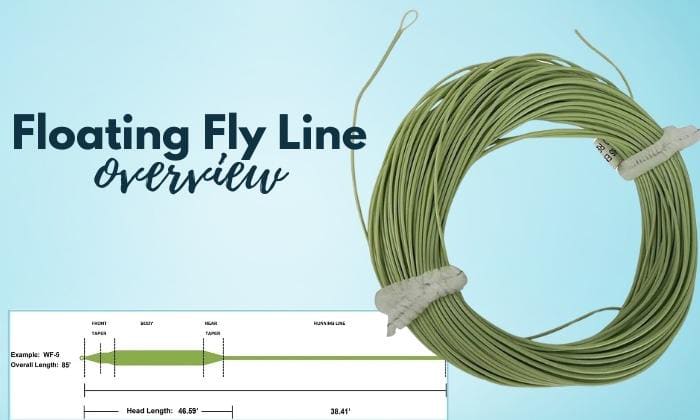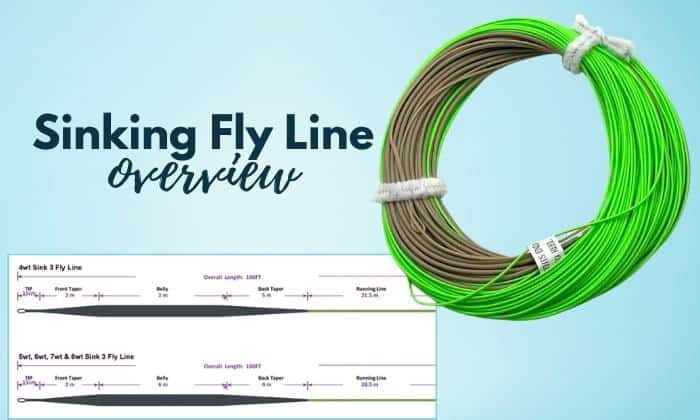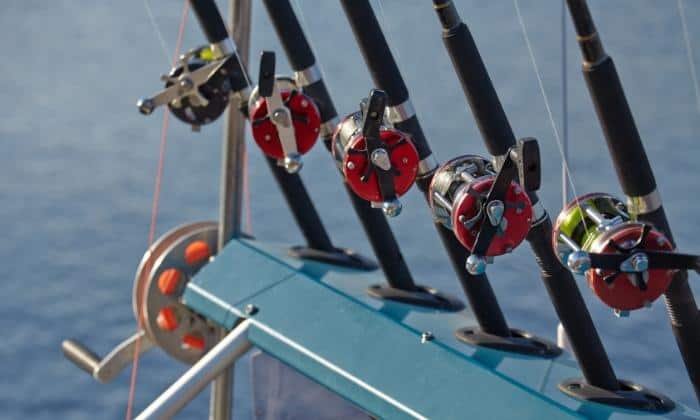As an angler, the journey to understanding fly lines’ significance and strategic selection is a process you can’t afford to skip. All fly lines share a similar purpose, but each type excels in specific situations.
Additionally, lines have different weight and sink rates that would affect your casting experience, and your choice will depend on your preferences and intended use.
For example, floating lines are best for surface fishing, while sinking lines work best in deep water.
This article will explore the enigma of floating vs sinking fly line. We’ll compare both types and help you choose the best gear for your needs.
Before we dive into the details, here’s a quick summary of the distinctions between floating and sinking fly lines:
| Floating Lines | Sinking Lines | |
| Application | Used primarily for surface or dry fly fishing | Best for wet or deep water fishing |
| Buoyancy | Floats on the water’s surface | Sinks deep into the water |
| Ease of casting | Easier to cast and control | Requires skill to cast effectively |
| Target species | Surface or near-surface feeders | Bottom-dwelling species |
| Wind resistance | More affected by wind | Less affected by wind |
| Line mending | Requires less effort to mend | More challenging to mend |
Page Contents
Floating Lines — Overview
A floating line is the simplest and most common type of fly fishing line. As its name suggests, it is designed to float on top of the water. The line has a core material coated with tiny air bubbles to keep it from sinking.
Generally, these lines are multipurpose. They are popularly used for streamers, dry-fly fishing, or throwing nymphs at certain depths. However, this depends on the exact fishing conditions and techniques you are using.
These buoyant lines are suitable for distance casting with long leaders or indicator rigs. If you’re an angler who enjoys exploring multiple rig setups, they could be worth considering.
Benefits of floating lines
- Versatile in most fishing situations
- Easy for beginners
- Subtle yet accurate presentations
- Better visibility and bite detection
Cons of floating lines
- Limited depth (around nine feet)
- More stretchy material, which makes hook setting difficult
- Can splash and spook fish
Sinking Lines — Overview
Sinking lines are the exact opposite of floating lines. They descend below the water surface at varying rates, targeting fish feeding at specific depths.
Due to its weight, a sinking fly line plunges quickly like a bullet in the water. Hence, it is particularly useful when fishing in deep waters, fast rivers, or aiming for species dwelling at the middle or bottom of the water column.
Sinking fly lines have two primary types, namely:
- Full sinking lines
The entire length of the line goes down the water. They are the fastest sinking lines, dropping three inches or more per second.
- Sink tip lines
Only a designated length of the tip or the sinking leader descends underwater.
Benefits of sinking lines
- Can reach extensive depths swiftly
- Keeps your fly down
- Wind resistant
- Efficient in fast-moving water
Cons of sinking lines
- Can be challenging to cast
- Unfriendly to inexperienced fly fishers
Which Line is Right for You?
Several factors determine whether a floating or sinking fishing line is the most appropriate in a given fly fishing scenario:
1. Fishing Situations
Floating fly lines work best in shallow waters or in situations where the current is slow.
In contrast, sinking lines are designed for deep waters and swift currents. A sink tip fly line is a fitting option when wading in rocky areas, while a full sink line is excellent for casting in stillwaters and areas without rocks.
2. Density and Weight
Density directly affects the buoyancy of the line and how it behaves in the water. Both lines are available in multiple densities, and choosing the appropriate weight can impact your success.
For your reference, here are AFTA-approved fly line weight specifications:
| Line Weight | Target Weight (Grains) | Target Weight (Grams) | ||||
| Low | Target | High | Low | Target | High | |
| 1 | 54 | 60 | 66 | 3.50 | 3.90 | 4.30 |
| 2 | 74 | 80 | 86 | 4.80 | 5.20 | 5.60 |
| 3 | 94 | 100 | 106 | 6.10 | 6.50 | 6.90 |
| 4 | 114 | 120 | 126 | 7.40 | 7.80 | 8.20 |
| 5 | 134 | 140 | 146 | 8.70 | 9.10 | 9.50 |
| 6 | 152 | 160 | 168 | 9.90 | 10.40 | 10.90 |
| 7 | 177 | 185 | 193 | 11.50 | 12 | 12.50 |
| 8 | 202 | 210 | 218 | 13.10 | 13.60 | 14.10 |
| 9 | 230 | 240 | 250 | 14.90 | 15.55 | 16.20 |
| 10 | 270 | 280 | 290 | 17.50 | 18.15 | 18.80 |
| 11 | 318 | 330 | 342 | 20.60 | 21.40 | 22.20 |
| 12 | 368 | 380 | 392 | 23.80 | 24.60 | 25.40 |
| 13 | 435 | 450 | 465 | 28.20 | 29.20 | 30.20 |
| 14 | 485 | 500 | 515 | 31.10 | 322.40 | 33.70 |
| 15 | 535 | 550 | 565 | 34.30 | 35.60 | 36.90 |
Realistically, the thinner the line, the more it floats on the water and vice versa. Sinking fly lines are typically denser than floating lines, and it’s the density that dictates the sinking speed, not the grain weight.
Hence, your choice will depend on how quick you want your fishing line to sink, since floating and sink fly lines typically have the same grain weights.
Besides, adjusting the leader length for a sinking fly line can also help present the fly at your desired depth.
3. Target Fish
As discussed earlier, a floating line is helpful when aiming for trout or other species that often feed on surface insects. Meanwhile, a sinking line would be the better option if you wish to land bottom feeders. This is often the case when fishing for pike or certain saltwater species.
4. Sink Rates
The sinking rate of a fly line is also a significant factor in choosing the perfect string for casting. Fly lines are rated in inches per second (IPS) and describe how quickly the line submerges itself in the water. The higher the IPS number, the faster a line sinks.
Depending on your casting style and preferred depth, you can choose a slow, intermediate, or fast sinking fly line. Refer to the estimates below:
- Floating lines – These only float.
- Sinking lines (1 to 1.5 IPS for slow types; 5 to 10.5 for fast-sinking designs; and 2 to 4.5 IPS for intermediate sink lines)
- Sink-tip lines (about 0.5 to 7 IPS)
Conclusion
There isn’t a definitive winner in the comparison of the floating vs sinking fly line. It all boils down to understanding your needs and specific fishing situation. No line is superior overall. Instead, both have unique benefits that are suitable for their intended use.
We hope this post has empowered you to match your tackle choices to your needs, thereby enhancing your efficiency, success, and satisfaction on the water.

Fishing is an important part of my day-to-day life and a wonderful way for me to bond with friends and family. Whether you fish for recreation, competition, or exercise, I hope you find the guides here helpful. Don’t hesitate to drop me a message if you want further help.





